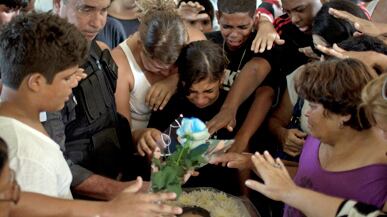Crowds watch crying as children are buried. Shell-shocked teenagers light candles and pray outside a public school. Flowers line a sidewalk. Closed-circuit TV images show terrified teenagers fleeing down a school corridor, followed by a neatly dressed man calmly reloading his revolver.
And a hardened TV reporter wipes her eyes after interviewing a little girl, who has just flatly described the cold-blooded murders of 12 of her schoolmates by a single killer.

The horrific scenes of a school massacre have been seen before in the UK, in Finland, in Germany, and a number of times in the United States. But never before in Brazil, where the appalling murder of 12 students at the Tasso da Silveira municipal school in Realengo, West Rio de Janeiro on Thursday April 7 has left the country in a state of shock.
Now the questions are being asked. How did this happen? Where did the killer get his guns? And why did Wellington de Oliveira, a 23-year-old, unemployed former student of the same school, carry out his appalling rampage?
The tragedy began a little after 8 a.m. Dressed neatly in black trousers and a dark green shirt, carrying a rucksack, de Oliveira entered the school saying he had come to collect the school report he had requested the previous week.
Inside, he met a teacher who recognized him. When she was called away he entered a first floor classroom where pupils were studying Portuguese, announced he had come to give a lecture – and took two revolvers, a .32 and a .38, out of his backpack.
He entered a first floor classroom where pupils were studying Portuguese, announced he had come to give a lecture—and took two revolvers, a .32 and a .38, out of his backpack.
"He began to shoot," Mateus Moraes, 13, told reporters. "Everyone dived on the floor, trying to hide under the desks, but he kept shooting. He entered and left the classroom four times."
Moraes was just a couple of feet from the gunman, praying for his life. "Relax fatty, I'm not going to kill you," de Oliveira told him. The boy told Globo News that the gunman shot to the girls to kill — and the boys to wound. Ten of the 12 dead were girls. Ten of the 14 wounded are boys. Three of the injured are still in critical condition.
Some students tried to flee upstairs. "I heard him saying, 'It won't help going up, I'm going to kill you,'" said survivor Jade Ramos, 13, to the O Globo newspaper. "They said, 'Don't kill me, don't kill me,' and he shot them."
It was her calm interview on TV Globo News that reduced a reporter to tears. "He said, 'Turn your backs, I'm going to kill you,'" said Yan Matos, another survivor.
Wellington de Oliveira went about his deadly business with ruthless efficiency. He fired more than 60 shots, using six speed-loaders to reload nine times.
He went into another classroom and kept firing. In an upstairs classroom, a teacher barricaded the door and told children to lie quietly on the floor. Trying to calm herself, Jade Ramos drew a picture of a house on her hand. It was the only thing she could think of to do.
But a boy who had escaped ran into the street and alerted nearby traffic police. Sergeant Márcio Alves confronted the gunman in the corridor, and shot him in the leg. De Oliveira refused to drop his weapon. Instead, he killed himself with a bullet to his head.
"I did my duty," Sergeant Alves, now being hailed as a "hero cop," told reporters. "If I had arrived five minutes later he could have gone to the next floor and there would have been more victims. We won't forget the children easily."
The first victim was rushed to the nearby Albert Schweitzer public hospital. "A child arrived who had been shot. That is not common," hospital director Dilson Pereira, 41, told The Daily Beast. Others followed – brought by car, police vehicle, and helicopter.
The hospital rapidly mobilized all available staff. Doctors and nurses on call were rushed to work. "There were wounds to the head, and to the thorax," said Dr. Pereira. "They were close-up gunshot wounds."
It wasn't until the end of the day that Dr. Pereira found out the details of what had happened. "It was very shocking. Children in serious states, wounded, dead, it was very emotional."
It quickly emerged that this was a premeditated crime: Wellington de Oliveira left a rambling suicide note with confused religious undertones. His body was to be wrapped in a sheet and handled by virtuous women.
The note was typed on a computer and printed out. "I need the visit of a faithful follower of God in my tomb. I need him to pray in front of my tomb asking the forgiveness of God," he wrote.
His note offered no explanation of a massacre that makes no sense. Nor did he explain it to anybody: de Oliveira was a loner. "He didn't have friends, he just stayed on the internet," his adopted sister, Rosilane, told Radio Band News. "He was really strange and reserved,"
A brother who refused to be named told Jornal Nacional news that de Oliveira researched shootings on the internet and wanted to destroy a plane. "Like they did in the United States," he said.
De Oliveira's biological mother apparently suffered from schizophrenia, he was raised by his adopted mother Dicéia, a devout Jehovah's Witness, with her other five children. She died 18 months ago. He said in his suicide note that he wanted to be buried next to her.
De Oliveira had good reports as a pupil at the Tasso da Silveira school, but he was mocked by fellow students. Interviewed by the Folha de São Paulo newspaper, one group of horrified former classmates even claimed that de Oliveira had chosen victims who looked like some of them.
He never had a girlfriend, shoving away one classmate when she jokingly came onto him, Thiago da Cruz, 23, told the newspaper. "She knew that to mock Wellington was a way to stay on the same side as the good-looking and intelligent ones in class," he said.
One of his nicknames was "Sherman," after the American Pie character. Another was "Swing," because of his limp. One student said: "Man, we're scared of you because one day you're going to kill a lot of people," former classmate Bruno Linhares, 23, told the O Globo newspaper.
After the death of his mother, de Oliveira lived alone in a house he had inherited in nearby Sepetiba, where he was nicknamed "Sheik" because of the long beard he grew. In August 2010 he was sacked from a job in a food warehouse. A manager told the same story: a solitary figure who didn't integrate.
As a boy, de Oliveira walked with his mother while she distributed Jehovah’s Witness literature. As a silent, polite, strange young man he walked around in shoes, black trousers and a shirt, in temperatures that can reach 40 degrees, while the rest of the population sported shorts and flip flops. He was a freak in a noisy, amiable country that has sociability wired into its DNA. Until one day he shaved the beard, trashed his house, burnt his computer, and went back to school: not to study, but to kill.
Like in the United States, gun ownership is common in Brazil, though by law gun owners must register weapons, prove no criminal record, and demonstrate "technical capacity" and "psychological aptitude."
But de Oliveira had no problem getting hold of one his two revolvers, the .32. He just went to his local locksmith.
On Friday, following a tip-off, police arrested locksmith Charleston de Lucena, 38, and unemployed Izaías de Souza, 48, on suspicion of having negotiated the sale of the .32 revolver de Oliveira used. They were neighbors of de Oliveira in Sepetiba.
De Oliveira paid R$260 ($165). The owner of the gun, as yet unidentified, received R$200 ($127). The two dealers got just R$30 ($19) each. De Oliveira told them he lived alone and needed the gun for protection. His other revolver, a .38, had been stolen 18 years ago.
Brazil now needs to ask itself searching questions about gun control and school security, which has already been increased in a number of cities. The country is no stranger to massacres, but they normally involve gang-related killings in favelas or brutally-repressed prison riots.
"We are all, men and women, united in repudiating this act of violence," said President Dilma Rousseff, in tears. "This sort of crime is not a characteristic of this country."
But Brazil is a country in the midst of rapid change. 30 million have climbed out of poverty in the last decade. Internet access is high - more Brazilians access social networks than Indians, a country with six times the population. Brazil is transforming itself, from third-world to first-world. And this is a first-world massacre.
The scruffy, residential district of Realengo is trying to come to terms with what happened on Thursday morning. The Presbyterian Church of Piraquara is feeding police and journalists who still surround the nearby Tasso da Silveira school. And it is grieving for one of its congregation: Larissa Atanázio, who was 14.
"She was a very pretty adolescent. She was very happy, very obedient, a really good person," church secretary Gilda Araujo, 60, told The Daily Beast. "I knew her since she was born. Her father is deeply shaken."
The church congregation is praying for him. "There is a crime here, but nothing like this has ever happened," Ms Aruajo said. "There is a huge sadness."
British journalist Dom Phillips moved to Sao Paulo, Brazil in 2007 to write his book Superstar DJs Here We Go (Random House/Ebury 2009) and works as a correspondent covering news, economics, and celebrity. He now writes for The Times, People, Financial Times, and Grazia.



